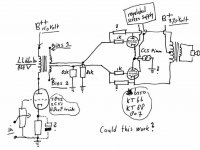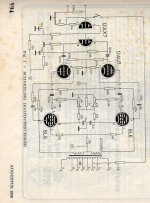could this work ? (PPamp with ccs)
I gathered some info left and right and came to this circuit (see attachment).
I am not good at tube theory, so I have some questions.
- If I choose for KT66, how much current should I use if i have a B+ of 370 volt ?
- Can I connect the Pimm ccs to ground or does it need a negative supply ?
- Can i differ between the two bias voltages to get the amp in balance ? How much bias voltage is needed for the best operating point (see first question) ?
I cannot afford to blow things up so your help is appreciated.
regards,
Jaap

I gathered some info left and right and came to this circuit (see attachment).
I am not good at tube theory, so I have some questions.
- If I choose for KT66, how much current should I use if i have a B+ of 370 volt ?
- Can I connect the Pimm ccs to ground or does it need a negative supply ?
- Can i differ between the two bias voltages to get the amp in balance ? How much bias voltage is needed for the best operating point (see first question) ?
I cannot afford to blow things up so your help is appreciated.
regards,
Jaap

Attachments
You may want to have a closer look at this one: http://www.vacuumstate.com/pow-amp.htm
The two advantages I can see with the un-bypassed shared cathode CCS is (1) that it improves common-mode and power supply rejection. But in a class A PP stage, if tubes are well matched, rejection is pretty good already, no matter what sits under the cathodes, within reason of course. And (2), the CCS forces the sum of the two tubes’ cathode currents to a set value which is more stable over time, aging, temperature, etc. than is achievable with either fixed bias or cathode bias. However, as you say, in overload, there is no stretch room beyond the fixed class A current, and this is the big limitation in a power stage. In circuits where each tube is separately cathode biased with its own bypassed resistor, there will be a frequency roll-off which does not occur with the shared CCS, but which also does not occur with RC biasing when the cathodes are directly connected (except for tube imbalances which convert some of the common-mode voltage to differential mode).
- Status
- This old topic is closed. If you want to reopen this topic, contact a moderator using the "Report Post" button.
- Home
- Amplifiers
- Tubes / Valves
- Could this work? (PP amp with CCS)

